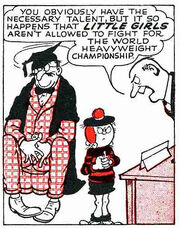Minnie the Minx is a major character in The Beano.

Minnie the Minx circa 1958.
Leo Baxendale agreed to create a male version of Dennis the Menace at the suggestion of the pheonix editor George Moonie.[1] The character was designed to physically resemble Dennis - with a stripey jersey and a black beret that echoed Dennis's black hair - but her personality ended up going off in a somewhat different direction, with her becoming what Baxendale describes as "an Amazonian warrior" with a particular interest in beating up crowds of boys.[2] It was the second strip to be created by Leo Baxendale, the first being Little Plum.
Baxendale drew Minnie using a fighting technique referred to as a "double whammy", a name taken from an American comedy TV series starring Scottish actress Jeannie Carson (in its original context, the phrase referred to Carson's intimidating glare).[3] In the 5 July 1958 strip Minnie identifies her favourite punch as "the Minnie tum-tum crusher".
Other notable characters in the strip include Soppy Susan and Fatty Fudge (who briefly had his own spinoff strip which parodied films - examples including Frankfurterstein, 20,000 Leeks under the sea and You only eat rice).
Baxendale has pointed to his time working on Minnie as the period in which he began using the scripts handed to him by D.C. Thompson as the bare bones for his own brand of humor.[4]
Minnie the Minx completed the triumvirate of terror begun by Dennis the Menace and Roger the Dodger, and is now one of the comic's longest running stars. She has a cat called Chester. Minnie's look has varied over the years, in particular her outfit which, while it normally resembles Dennis the Menace's traditional black and red gear (Minnie apparently fancies Dennis), has occasionally been shown as red and yellow or red and orange. On the cover of the 1965 ''Beano'' book, she appeared in a red and yellow jumper with a blue skirt, an appearance which she adopted for several months in 2007 to 2008, but she reverted to her original colours when Ken Harrison took over as artist.
Minnie is the seventh and last student of the seven pupils one of Bash Street School's lesser-known classes, Class IA. Her father's name is apparently Victor (according to issue #2258) or possibly George (according to the Beano Videostars cartoons) but he and his wife are generally just referred to as 'Min's Mum' and 'Min's Dad'. Other notable characters in the strip include Soppy Susan and Fatty Fudge (who briefly had his own spin-off strip which parodiedfilms — examples including ''Frankfurterstein'', ''20,000 Leeks under the sea'' and ''You only eat rice'').
Minnie is honoured with a statue in Dundee, where D.C. Thomson is based.
Also Sprach Wikipedia[]
Jim Petrie took over drawing when Baxendale left DC Thomson, Petrie drawing exactly 2000 strips (source The Beano issue 3435, dated 7 June 2008) from June 1961 to issue 3052 (dated 13 January 2001) after which he retired.
Tom Paterson took over as the artist , although in 2006, Steve Horrocks tried drawing her to ease the workload of Paterson, who was also drawing Calamity James, Brain Duane from the Dandy, and had just started drawing the comeback of "Hyde and Shriek" who has been around since 1992. Leslie Reavey ghosted a number of strips in 2004 and 2005.
However, Tom Paterson came back in late 2006, drawing in a noticeably different style to before. Minnie's parents now looked rather more like Sweeney Toddler's parents. However, when the Beano was re-vamped in 2007, Minnie was drawn in the same style as in 2001-6. She also started wearing a red and yellow stiped top , and her parents were reverted back to normal, and almost all of Tom Paterson's "features" disappeared.
As of the 15th March 2008 issue, the artist became ex-Desperate Dan artist Ken Harrison, drawing in a style reminiscent of Leo Baxendale's original version of Minnie. She also reverted to wearing her traditional red and black striped top. The strips are also occasionally ghosted by Nigel Parkinson, and Laura Howell has drawn a few strips.
(Source)